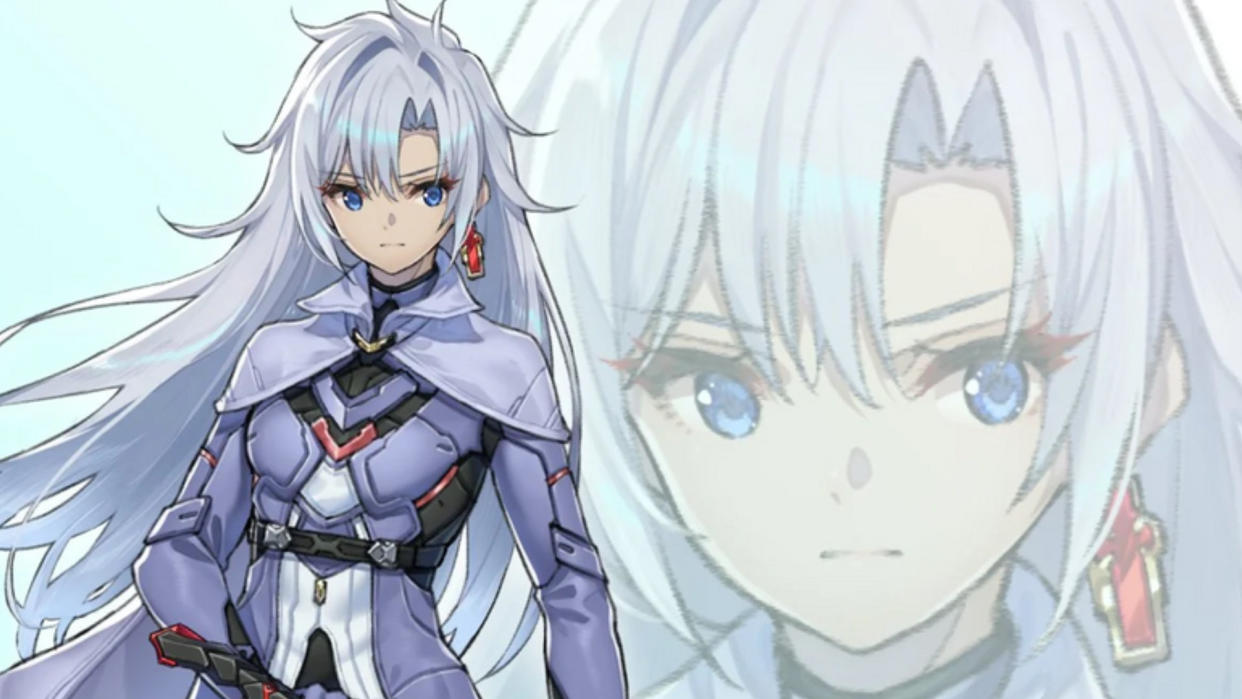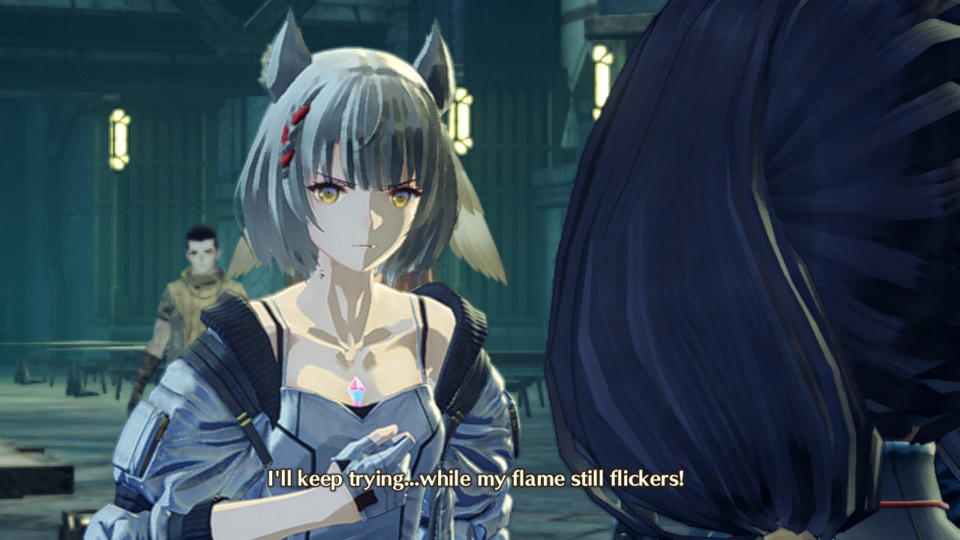I don't really care if Xenoblade Chronicles' A is nonbinary

I had already played some 250 hours of Xenoblade Chronicles Definitive Edition, Xenoblade Chronicles 2 and last years’ Xenoblade Chronicles 3 when I began the trilogy's conclusive story DLC, Future Redeemed. Released in April of this year, the original prequel story was billed as the final chapter of the series so far that would recontextualize the events of Xenoblade Chronicles 3 and solidify the overarching, interconnected story of all three games. That was a big deal for me because, if my time alone with it wasn’t clear, I love Xenoblade.
In 2020, picking up XCDE and diving deep into its sequel XC2 got me through the hardest growing pains of both the pandemic and a post-graduate depression. In 2022, I reviewed the latest entry to the series in one of the highlights of writing career. And earlier in 2023 I sat down with Future Redeemed on my own terms to enjoy whatever hallmark ridiculousness Monolith Soft gad in store for players. Maybe, I thought, it would bookend the past three years of my life the same way it did the trilogy. What I got instead was weeks of transphobia-laden discourse online that nearly burned any and all fondness I have for the series.
Which isn’t the fault of the game itself. Future Redeemed delivered on it’s biggest promises. It’s a mechanical treat, an exploratory delight, a feast for long-time Xeno- fans, and a thematic and narrative conclusion to a decade spanning sci-fi opera. No, what made me want to jettison everything Tetsuya Takahashi and his team at Monolith Soft have ever made into the sun. It was the Xenoblade fans.
Xenoblade’s fandom is normal in all the worst ways: It latches onto any criticism of the beloved series as a personal offense and prioritizes the opinions of a vocal minority of cishet men. Reasonable responses to Xenoblade Chronicle 2’s character designs are still met with exacerbation, whether expressed in published articles or in fan forum comments. The community has even made memes out of inaccuracies in various reviews from major outlets as a way to express that any criticism is invalid. As both a queer fan that has an ambivalent fondness for the series and as a journalist that has covered the games, I have kept my distance from fandom spaces.
Wielding a thin red sword, A travels together with Matthew. A is the type to make calm, calculated decisions, making for a good partner for Matthew, who tends not to think his actions through. #XenobladeChronicles3 pic.twitter.com/1G8c9kFh6kApril 20, 2023
I couldn’t stop looking at the response to Future Redeemed though, because suddenly the topic of discourse was a trans character introduced in the DLC, A. A is an aegis — a powerful weapon and one avatar of a processor in a sci-fi supercomputer called the Trinity Processor — and, depending on who you ask, A is nonbinary. Why the caveat? Well, it may have something to do with the inconsistent behavior of computers in the series, coding values for gender, presumed sociocultural norms, split personalities, the absence of pronouns, and even the Jungian archetypes of anima and animus as used in 1998’s Xenogears. And I’m not really interested in litigating what those arguments all are, because I don’t really care that A isn’t nonbinary.
There’s a version of this article about how games and stories are what we make of them, and that A is nonbinary because I say A is. That looking to coding values that don’t appear in the text itself is just ridiculous and that characters are presumed straight and cis by default so there is an undue burden of proof to justify any interpretation that a character is queer. But why exactly then did A — and the characters embrace as nonbinary representation—garner such vitriol? The walls of text under fan art on social media and weeks of discourse looming over all discussion of Future Redeemed had to be more than just the normal misogyny and transphobia you’d expect to find in gatekeepy gamer spaces
And, well, I’m starting to think we just like Xenoblade for different reasons. That Xenoblade is, to many, an encyclopedia that has been unraveled like a puzzle box. Or perhaps its lore is a puzzle that can be pieced together with only a little sanding down the edges to make everything fit together nicely. And that if you’re a dude with a YouTube channel who can recite all the lore from umpteen JRPGs all loosely tied together by their developers that you have some authority over others personal understandings of what Xenoblade means to them — even the characters’ actors.
To me, Xenoblade is a game with themes. And playing Future Redeemed solidified that the overarching struggle of the entire trilogy has been about the condemnation of freedom, the universal anxiety of the unknown in our future, and hope in the face of it all. To others, Future Redeemed connected the timeliness of Xenosaga and Xenoblade together. And that’s cool too, I guess.

In his 2019 essay on fandom and authorship titled “Canon is an abyss,” writer Mike Rugnetta described how canonicity has become the preeminent mode of engagement for big budget media in the 21st century. From Star Wars to Dark Souls to Harry Potter, popular stories of all mediums are being “designed as deeply abyssal.” Think about the proliferation of meta-text in the Star Wars sequel trilogy, how a key plot point of the Rise of Skywalker is introduced in Fortnite. Or how Harry Potter lore continues to be rewritten on Twitter. And then there’s Dark Souls’ deep, ambiguous world histories and scaffold of a narrative begging to be pieced together, if only you could find all the right pieces.
Xenoblade shares many of these abyssal qualities with its Christian imagery, psychoanalytic motifs, and it’s sci-fi lore. None of those things, however, are narrative. And when fans prioritize the encyclopedic collections of facts as “lore” or “canon” over what authors and readers/players make of the actual stories being told, stories with characterization and thematic through lines, the value of the media itself comes into conflict.
In terms that echo the very same battles of Ouroboros’ fight against Moebius in Xenoblade Chronicles 3, Rugnetta describes how how engaging with these texts purely on the level of their canonicity is unproductive: “It is the bottomless pit of failing to move past, in which one might search fruitlessly for answers neither provided nor possible.” Like the infinite now the player characters of Xenoblade have fought, it is a comfortable positionality that doesn’t challenge players.
This manifests in Xenoblade discourse as a deep conservatism and major skepticism towards anything that is not explicitly named. Even after Xenoblade Chronicles Definite Edition retconned the character design of A’s original form, Alvis, to align more closely with the Aegis’ of XC2, many still denied the obvious implication that Alvis is and always was an Aegis and the missing core of the Trinity Processor. To return to our puzzle metaphor, there was one piece left to fill in the section, but many players were too skeptical to assume the empty outline must be it’s proper shape. In all these words. So, in all these words I haven't actually gotten to say what Xenoblade is, but rather what it is not and what it could be."
So what would it mean to queer our relationship to abyssal media? It might mean to embrace reclaimed characters while still maintaining a skepticism towards developers and publishers who minimalize non-normative identities in their games and their studios. Both A and Juniper, a nonbinary character in the base game of XC3, are simply never gendered. And while many trans people in our world do simply not use pronouns, the pattern is already clear: This omission, which would’ve taken conscious effort among writers and translators, maintains a plausible deniabilty for conservative fans that has become the dominant (and they’ll hate me for saying this) headcanon among Xenoblade fandom.
A is nonbinary because if the legendary swords that come from different parts of a super computer that harnesses the power of a fantastical cross-shaped power source each representing different perspectives on life are going to be represented by gender, then everything sure seems set up for A to be neither male nor female, but positively something else. And yes, in a better world, we would not need to reclaim characters, because among the dozens of characters in Xenoblade’s cast there would be more to latch onto than the hints of queerness in Morag, the coming out allegory of Nia, or the coding values behind Juniper.
And yes, there are indeed queer characters to be found elsewhere in the AAA and indie space, characters made by trans people that represent all our complexities. But in that better world, if giant games publishers are still there, I’d still want to play Xenoblade. And I’d want to see the story the team behind the series could tell not for the tiny imaginations of people that care that A isn’t — technically — nonbinary.
Every day this week we're running content to celebrate Pride month. Next, why not read into how video games help us to understand our gender and sexuality, or celebrate Birdo's role as a trans icon.

